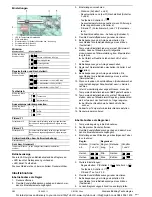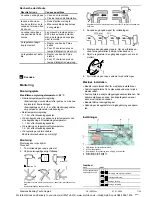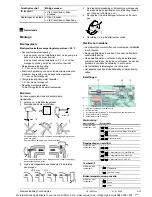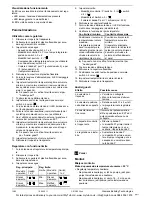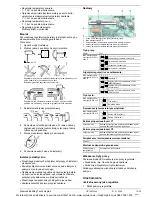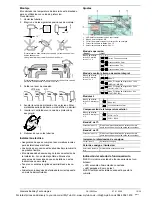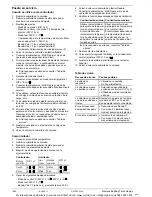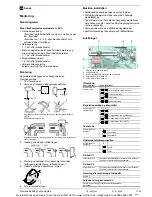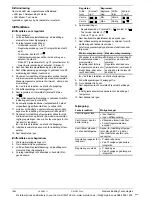
4/20 18.08.2011 CE1G3333xx
Siemens Building Technologies
Operating action:
Where?
What?
1 2
Heating and cooling in sequence
DIP switch block,
switches no. 1 and 2
Two-stage heating
Single-stage cooling
Single-stage heating
Control mode and integral action time:
3 4
P-mode
PI mode, integral action time = 120 s
(MEDIUM)
PI mode, integral action time = 240 s
(SLOW)
DIP switch block,
switches no. 3 and 4
PI mode, integral action time = 60 s (FAST)
Test mode:
5
Test mode
DIP switch block,
switch no. 5
Normal operation
Outside temperature compensation:
DIP switch block,
switch no. 6
6
HIGH
LOW
P-band Y1
Potentiometer no. 5
Potentiometer setting should correspond to the re-
quired range of the controller’s output signal
P-band Y2
Potentiometer no. 4
Potentiometer setting should correspond to the re-
quired range of the controller’s output signal
Setpoint increase / decrease:
Slider 3
Setpoint or limit value:
Temperature
setting slider 5
Adjust after commissioning
Indication of operating state
The red LED indicates the controller’s operating state:
•
LED lit: Mains voltage present
•
LED flashes: In test mode
The LED is also visible when the cover is fitted.
Commissioning
When used as a controller
1. Remove housing cover.
2. Lift flexible plastic cover so that you can access the
setting elements.
3. Make
the
settings:
−
Operating mode (switches no. 1 and 2)
−
Control mode and (with PI mode) integral action
time (switches no. 3 and 4)
−
Test mode: Switch no. 5 =
−
Outside temperature compensation (when using an
outside sensor)
−
P-band Y1 (potentiometer 5) and Y2 (potentiome-
ter 4)
−
Setpoint increase or decrease (slider 3)
4. Replace flexible plastic cover.
5. Switch power on. LED for the operating state must
flash (test mode).
6. First, set temperature setting slider to the minimum
value, then to the maximum value: Actuating device(s)
must travel to the minimum or maximum position.
►
If response is wrong, refer to “Troubleshooting”
7. Switch power off.
8. Switch controller to normal operation (set switch no. 5
to
).
9. Switch power on. LED for the operating state must
light up (normal operation).
10. If used, activate auxiliary functions (setpoint change-
over, load-dependent switching contact, etc.).
11. If a remote setting unit is used, set the controller’s
temperature setting slider to EXT.
12. First, set temperature setting slider to the minimum
value, then to the maximum value: Observe the con-
trol. The response may neither be too fast nor too
slow.
►
If response is wrong, refer to “Troubleshoot-
ing”
13. Adjust the setpoint with the temperature setting slider.
14. Replace housing cover.
As a limiter
1. Switch on the temperature control.
2. Remove housing cover (limiter).
3. Lift flexible plastic cover so that you can access the
setting elements.
4. Choose operating action according to the following
table:
Controller:
Limiter:
Operat-
ing mode
Switches
1 and 2
Limita-
tion
Operating
mode
Switches
1 and 2
Heating
Min.
Heating
Heating
Max. Cooling
5. Make the following additional settings:
−
Control mode: P (switch no. 3 =
, switch no. 4 =
)
−
Test mode: Switch no. 5 =
−
P-band Y1 on approx. 25 K
6. Replace housing cover.
7. Switch power on. LED for the operating state must
flash (test mode).
8. Check function depending on the type of limitation:
With minimum limita-
tion:
With maximum limitation
Set temperature setting
slider to the maximum
value:
Controller must increase
the temperature (heating
valve must open, cooling
valve must close)
Set temperature setting
slider to the minimum
value:
Controller must reduce the
temperature (heating valve
must close, cooling valve
must open)
►
If response is wrong, refer to “Troubleshooting”
9. Switch power off.
10. Switch limiter to normal operation (set switch no. 5 to
)
11. Adjust the limit temperature.
12. Replace housing cover.
For latest prices and delivery to your door visit MyTub Ltd - www.mytub.co.uk - [email protected] 0844 556 1818


